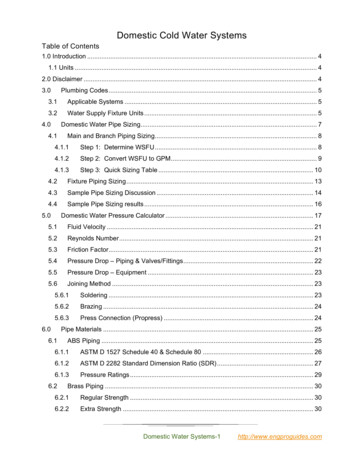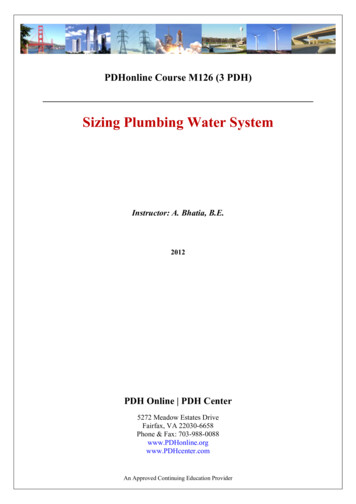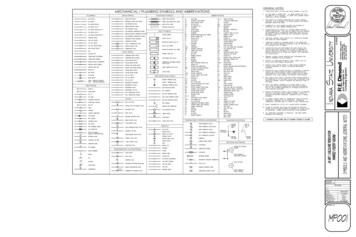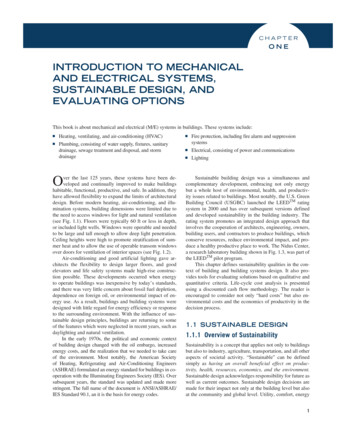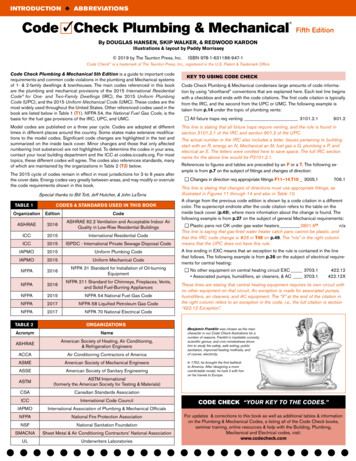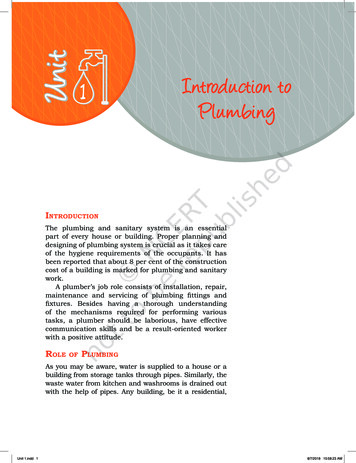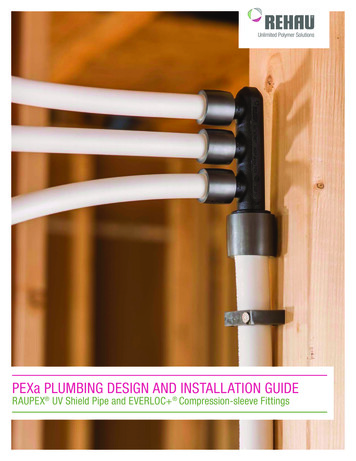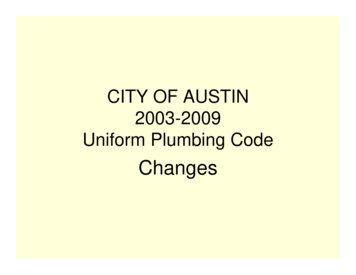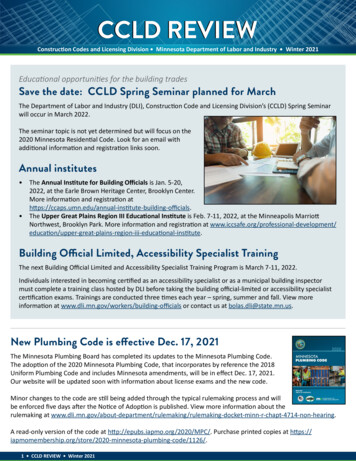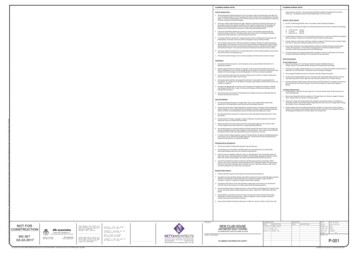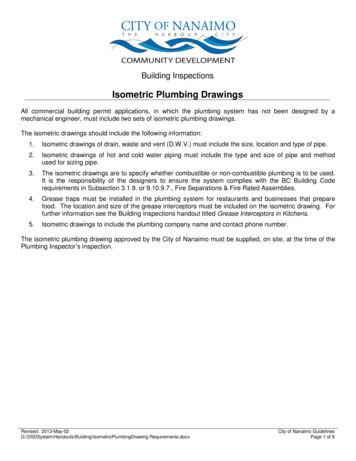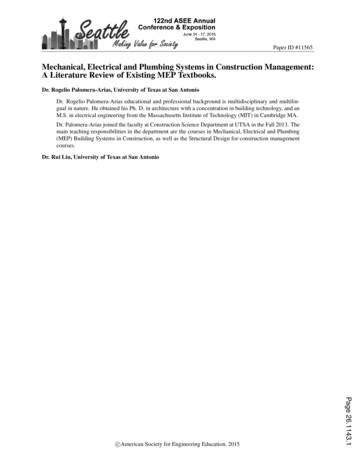
Transcription
Paper ID #11565Mechanical, Electrical and Plumbing Systems in Construction Management:A Literature Review of Existing MEP Textbooks.Dr. Rogelio Palomera-Arias, University of Texas at San AntonioDr. Rogelio Palomera-Arias educational and professional background is multidisciplinary and multilingual in nature. He obtained his Ph. D. in architecture with a concentration in building technology, and anM.S. in electrical engineering from the Massachusetts Institute of Technology (MIT) in Cambridge MA.Dr. Palomera-Arias joined the faculty at Construction Science Department at UTSA in the Fall 2013. Themain teaching responsibilities in the department are the courses in Mechanical, Electrical and Plumbing(MEP) Building Systems in Construction, as well as the Structural Design for construction managementcourses.Dr. Rui Liu, University of Texas at San AntonioPage 26.1143.1c American Society for Engineering Education, 2015
Mechanical, Electrical and Plumbing Systems in ConstructionManagement: A Literature Review of Existing MEP Textbooks.AbstractThis paper reviews the most common textbooks used in courses covering Mechanical, Electricaland Plumbing systems in construction science and management programs accredited by theAmerican Council for Construction Education (ACCE) in US institutions. The review provides acomparison of the textbook’s topics and subject areas covered, and their relation to the MEP andspecialty contractor skills and knowledge required by construction management graduates inorder to perform their jobs, whether in a general contractor or a specialty contractor firm. Thepaper also highlights the achievements, as well as the shortcomings of the reviewed MEPtextbooks in supporting the learning objectives of traditional construction management coursessuch as print reading, estimating, scheduling and other related subjects.IntroductionMechanical, electrical, plumbing and related systems (MEP systems) have become one of thebigger contributors to the building construction costs. They are also heavy contributors of theenergy consumption in buildings[1], as well as their operation and maintenance costs. This has ledto a general recognition of the importance of MEP systems in today’s construction industry.Consequently, the various accreditation organizations for higher education in the fields ofconstruction have recognized and require MEP content to be covered in the curricula ofconstruction science, management, and technology programs[2]. Such coverage includes theselection and/or generation of appropriate literature, such as textbooks, supporting the teachingof MEP systems in construction.This paper reviews the most common textbooks used in courses covering MEP systems inconstruction science and management programs accredited by the American Council forConstruction Education (ACCE) in US institutions. The various programs were surveyed todetermine the textbook requirements, if any, of their MEP course offerings. The five most usedtextbooks are reviewed for topics and subject areas covered, as well as for the their main focus.The paper ends with a discussion and comparison of the books reviewed, and their role insupporting the development of the skillsets and knowledge expected from construction scienceand management students as it relates to the field of MEP systems construction.Textbook AdoptionsPage 26.1143.2As of the academic year 2014-2015, there were 73 construction science and managementprograms accredited by the ACCE. These programs offer a total of 105 required MEP courses.Reviewing publicly available course information from the school catalogs and bookstoreswebsites, the authors found that 81 of these courses used a total of 17 different books as requiredcourse materials. These books varied from textbooks to specific building-code books andhandbooks. The remaining 24 MEP courses did not require a textbook, or information was not
available regarding textbook requirement at the time of the survey. Table 1 presents thebibliographic information of the seven most common used MEP books in the schools surveyed.Table 1 Most Common MEP Textbooks )2(1.8%)2(1.8%)TitleMechanical and Electrical Systems inBuildingsMechanical and Electrical Systems forConstruction ManagersMechanical and Electrical Systems inArchitecture, Engineering and ConstructionMechanical and Electrical Equipment forBuildingsDesign of Mechanical and ElectricalSystems in BuildingsNFPA 70: National Electrical CodeEd. Year5thAuthorsPublisher2014 Janis & TaoPrentice Hall 97801380156263rd 2013 ATP StaffATP97808269936325th 2010 Dagostino & Wujek Prentice Hall 978013500004511th 2010Grondzik et al.Wiley1st2004 Trost & Choudhury Pearson--2014National FireProtection Assoc.NFPA14th 2012 Mullin & Simmons CengageElectrical Wiring 9067279781435498297Figure 1 shows the distribution of textbook adoptions in ACCE Construction programs. In thechart, books having less than 2% adoption were grouped together under the “Other References”category. The chart also shows the percentage of schools with no textbook reported, and thoseusing custom books. Custom books are books produced by publishing companies using sectionsfrom existing books with additional content provided by the course instructors.MEP Textbook AdoptionsOther References13%No Text/Unknown22%Custom Books3%Trost &Choudhury5%Grondzik et al.8%Janis & Tao21%Dagostino &Wujek11%ATP Staff17%Figure 1 Distribution of MEP Textbooks Adoption within ACCE Construction Programs.Page 26.1143.3For the courses that had a textbook requirement, the majority of them specified a single textbookfor the course, with a few courses requiring two or three different books. Nevertheless the great
variety of reading and reference materials available covering MEP materials, five textbooksstood out as the main selections by MEP courses instructors: “Mechanical and ElectricalSystems in Buildings” written by Janis & Tao[3], “Mechanical and Electrical Systems forConstruction Managers” published by the staff at American Technical Publishers (ATP)[4],“Mechanical and Electrical Systems in Architecture, Engineering and Construction” byDagostino & Wujek[5], “Mechanical and Electrical Equipment for Buildings” by Grondzik etal.[6], and “Design of Mechanical and Electrical Systems in Buildings” written by Trost &Choudhury[7]. The other twelve textbooks used by the MEP courses were required by less thantwo courses each.Textbook ReviewsThe five most common MEP textbooks were reviewed, as mentioned previously, for thecoverage of MEP content and the main focus of such coverage. Table 2 shows the number ofchapters that each textbook dedicates to the following subjects:1. Building science: topics include fundamentals of building heat transfer, psychrometrics,building material thermal properties, indoor air quality, and comfort concepts.2. HVAC systems: this includes HVAC equipment, distribution and delivery systems, loadcalculations, and refrigeration principles.3. Electrical systems: this includes electricity fundamentals, loads and power, wiring materialsand methods, service entrance equipment and switchgear, utilization devices, and mightinclude low-voltage systems such data and communications.4. Lighting systems: this includes electric lighting systems and controls, lighting devices andfixtures, as well as light properties and fundamentals.5. Plumbing systems: includes materials and methods for clean water supply and distribution,DWV (drain, waste and vent) systems, storm drains. It also covers plumbing fixtures, andsystem loads and sizing.6. Fire protection systems: includes fire suppression systems and equipment, and might includefire alarms and other life protection and safety systems.7. Others: this category encompasses coverage of topics and systems that do not fall directlyunder the MEP categories defined previously. These include architectural design principles;acoustics and noise control systems; testing and inspection; passive solar and daylightingsystems, conveyance systems, and sustainable systems if not covered as a subset of the MEPsystems. Also included in this category is MEP system coordination, which is covered onlyby one textbook in the group.Table 2 Number of Chapters Used by MEP Subject Area in Reviewed TextbooksTextbookAuthorJanisATP 146640*26616544FireProtection10111Some commercial lighting systems are mentioned in the last electrical chapterOthers22392Page 26.1143.4*Pages
The following subsections summarize each textbook individually, presenting the generalapproach to the MEP topics, and a description of their organization and content delivery. Adiscussion and comparison of all the textbooks is presented then in the final section of this paper.A. “Mechanical and Electrical Systems in Buildings”, 5th Ed. by Janis & TaoIn “Mechanical and Electrical Systems in Buildings” book, MEP equipment, materials andmethods are presented with detailed text descriptions with hundreds of photographs anddiagrams to supplement the descriptions. The textbook also uses data tables extensively topresent and compare properties and typical performance values of the equipment described in thetext. The textbook is very consistent in the format it presents HVAC, plumbing and electricalsystems: fundamental theory and principles governing the systems, followed by descriptions ofequipment, materials and methods, and systems layouts; and ending with system design andsizing methods with fully explained and worked examples. Each chapter includes at the endproblems and exercise pertaining to the material covered in the chapter.The textbook provides coverage of MEP construction drawings, presenting common symbolsand abbreviations used. Plans, riser diagrams, as well as isometric sketches are presented tosupplement the systems descriptions. Also, this is the only book of that introduces the concept ofsystems coordination, and as such provides common installation and clearance requirements forthe various systems. The coordination information is provided using detailed installationdrawings and diagrams in various locations throughout the text, and summarized in a chapter atthe end of the textbook.Building load calculations, system selection and sizing methods for the main MEP systems areintroduced in the book through text description with very few examples. General designguidelines for each system are also presented. The design methods used are based on algebraicequations and the use of charts and tables. However, the authors over simplified the equations tothe point where the units and meaning of the constants used in the equations might be lost to thereader. The textbook also provides a good presentation of building science concepts and thermalloads calculations using simplified methods. It also introduces the reader to simplified methodsof estimating heating and cooling energy consumption of buildings.In addition to the main MEP and lighting systems, the book also covers noise and vibrationcontrols. It does not cover, as other textbooks, concepts of solar systems, sustainability, noralternative energy systems in buildings, with the exception of short mentions of daylighting andnatural ventilation in buildings. It provides, however, a good introduction to MEP coordination,and a very basic introduction to economic analysis of MEP system design choices using theconcepts of payback period and initial and operation costs.B. “Mechanical and Electrical Systems for Construction Managers”, 3rd Ed. by ATP StaffPage 26.1143.5“Mechanical and Electrical Systems for Construction Managers” presents MEP equipment,materials and methods using detailed text descriptions and two-color illustrations, photographs,and diagrams. The illustrations are clear and present good details regarding system installation.
Each chapter includes at the end review questions pertaining to the material covered in thechapter.This textbook, the only one amongst the reviewed group, provides basic coverage of testing,measurement, and inspections tools and procedures for MEP systems. It also has a dedicatedchapter on building automation and controls. However, it does not provide any information onmechanical or plumbing plans and specification reading and interpretation. Only electrical plansare covered briefly. Isometric drawings of plumbing systems are presented as part of the systemsizing and design examples.Building loads calculations, system selection and sizing methods for the main MEP systems arepresented clearly using meaningful and well-explained and illustrated examples. However, theequations used are limited to the English system of units, and similar to Janis & Tao textbook,the physical constants used in the equations have no indication of their units or their explicitmeaning.In addition, the scope of the textbook is limited to the three main MEP systems: HVAC,plumbing, and electric power and distribution. Other systems, like fire protection, alternativeenergy systems, and sustainable systems are not covered anywhere in the book. Furthermore,electric lighting systems coverage is limited to a few paragraphs within the commercial circuitschapter of the book.C. “Mechanical and Electrical Systems in Architecture, Engineering and Construction”, 5th Ed. byDagostino & WujekIn the “Mechanical and Electrical Systems in Architecture, Engineering and Construction”textbook, MEP equipment, materials and methods are presented with detailed text descriptionsand over 800 pictures and diagrams used to supplement the descriptions. The textbook also usesdata tables extensively to present and compare properties and typical performance values of theequipment described in the text. The textbook is very consistent in the format it presents HVAC,plumbing and electrical systems: fundamental theory and principles governing the systems,followed by descriptions of equipment, materials and methods, and systems layouts; and endingwith system design and sizing methods with fully explained and worked examples. Each chapterincludes at the end problems and exercise pertaining to the material covered in the chapter.The textbook provides good coverage of MEP construction drawings, presenting commonsymbols and abbreviations used, as well as listing of information requirement of plans and specs.Plans, riser diagrams, as well as isometric sketches are presented during the system layout anddesign examples throughout the book. However, no coverage of plans and specs is presented forfire protection systems, communications systems, or conveyance systems.Page 26.1143.6Building loads calculations, system selection and sizing methods for the main MEP systems arepresented clearly using meaningful and well-explained and illustrated examples. The designmethods used are based on algebraic equations and extensive use of charts and tables. Thetextbook also provides a good presentation of building science concepts and thermal loads
calculations using simplified methods. It also introduces the reader to simplified methods ofestimating heating and cooling energy consumption of buildings.In addition to the main MEP and lighting systems, the book also covers acoustic control systems,conveyance systems, passive solar and daylighting systems, as well as sustainable and alternativeenergy systems.D. “Mechanical and Electrical Equipment for Buildings”, 11th Ed. by Grondzik et al.The “Mechanical and Electrical Equipment for Buildings” textbook is the longest of all thebooks reviewed. It presents the various MEP systems using a combination of text descriptions,sketches and pictures to describe equipment, materials, operation principles, as well as basicdesign concepts. Detailed architectural drawings of MEP components and installation details areused extensively throughout the book to supplement the descriptions provided in the text.Coverage of plan and specs reading and interpretation varies with the system covered, withelectrical system receiving the most coverage and HVAC systems the least coverage. MEP plansand riser diagrams are presented as part of building examples used to explain the design andsizing processes. Load calculations and systems sizing methods presented are based on the useand application of algebraic equations, charts and tables.The book provides extensive coverage of traditional MEP systems as well as updated coverageon recent developments on MEP systems. It also covers sustainable and renewable systems,including passive and active solar systems. However, the coverage provided is mainly from anarchitect’s design perspective, with some engineering background. In addition to MEP systems,this book also provides extensive coverage of lighting and daylighting design principles,architectural acoustics fundamentals, sound and noise control systems, and conveyance systems.E. “Design of Mechanical and Electrical Systems in Buildings” by Trost & Choudhury.“Design of Mechanical and Electrical Systems in Buildings” presents the MEP concepts byproviding practical design examples using simple realistic building plans from which the designprocess is explained. Design methods are based on using simplified calculations, and the properuse of charts and tables. It explains how to read and interpret the various MEP plans in simpleterms, and indicates how information is typically presented on them. It also shows how to readand create various schedules used in MEP plans, especially electrical schedules.Devices and equipment, as well as MEP materials and methods, are presented using short textdescriptions, supplemented with sketches and perspective drawings. The textbook has nophotographic images. Sketches and drawings are used to convey that same information that othertextbooks do using photographs.Page 26.1143.7In addition to covering the basic MEP systems, the authors also cover concepts of daylightingand solar thermal systems. However, it doesn’t cover other renewable systems such asphotovoltaic systems or heat recovery systems. In addition to that, the textbook would benefitfrom an update to incorporate new developments in MEP systems, for example adding coverage
of LED’s in the lighting section, including the newer NEC requirements in the electrical designsection such as the use of AFCI’s, and adding other developments in the subject of sustainableMEP systems. Of the five books reviewed, it is the shortest and oldest one with a single edition.DiscussionThe five textbooks reviewed support, more or less, the typical set of course goals and objectivesdefined for most of the required MEP courses offered in the ACCE accredited constructionprograms. These objectives can be summarized as, Develop an understanding of the fundamental principles governing MEP systemsConduct basic thermal, hydraulic, and electrical load calculationsDevelop an understanding of materials and methods, and equipment used in MEP systems.Develop an understanding of the design principles of MEP systemsConduct basic sizing and layout of MEP systems based on the building specifications, loadsand demandsRead and interpret construction plans and specifications.The depth and scope of the coverage for each system varies across textbooks, as well as withineach individual book. For example the ATP book covers only HVAC, plumbing and electricpower systems, while Grondzik’s and Dagostino’s books cover all the MEP systems as well asacoustic systems, conveyance systems and additional topics regarding sustainability andarchitectural design. Table 3 summarizes each of the textbooks content supporting the typicalMEP course objectives for HVAC, plumbing, electric power, electric lighting, low voltage, andfire protection systems. It also shows additional coverage in the textbooks for other systemsbeyond the traditional MEP systems. All the books have some mention of the relative MEPsystems costs without providing actual values, or without indicating whether the MEP associatedcosts derive primarily from the materials cost or the associated labor and equipment costs.Janis & TaoATP StaffFundamentals and PrinciplesMaterial and MethodsThermal LoadsSystem Design and SizingEquipment SelectionPlan Reading and SpecsFundamentals and PrinciplesMaterial and MethodsHydraulic LoadsSystem Design and SizingEquipment SelectionPlan Reading and SpecsFundamentals and PrinciplesMaterial and MethodsElectric LoadsSystem Design and SizingEquipment SelectionXXXXXXXXXXXXXXXXXXXXXXXXXXXXXXXXDagostino &WujekXXXXXXXXXXXXXXXXXGrondzik etal.XXXXXXXXXXXXXXXXXTrost &ChoudhuryXXXXXXXXXXXXXXXXXPage ble 3 Textbook Coverage of MEP Course Goals and ObjectivesSubject
ageSubjectJanis & TaoATP StaffDagostino &WujekXXXXXXXGrondzik etal.XXXXXXXPlan Reading and SpecsFundamentals and PrinciplesMaterial and MethodsIllumination RequirementsSystem Design and SizingEquipment SelectionPlan Reading and SpecsFundamentals and PrinciplesMaterial and MethodsSystem Design and SizingEquipment SelectionPlan Reading and SpecsFundamentals and PrinciplesMaterial and MethodsSystem Design and SizingEquipment SelectionPlan Reading and SpecsSustainable SystemsMEP Systems CoordinationTesting and InspectionsBuilding AutomationNoise Control and AcousticsConveyance SystemsXXXXXXXXXXXXXXXXXXXXXXXXXXXXXXTrost &ChoudhuryXXXXXXXXXXXAll the textbooks follow similar methods for calculating building loads, and for the design andsizing of systems. However, the book published by ATP defines and restricts its methods andequations to the English units system only.None of the textbooks reviewed provides coverage of what is typically considered advancedtopics in MEP construction, such as MEP estimating, scheduling, or project management; andwith the exception of Janis & Tao’s book, none of the books cover the subject of MEP systemcoordination either. Other topics relevant to MEP systems construction and absent from all thetextbooks are discussions on prefabrication, constructability issues such as installationequipment, lifting and rigging requirements, and proper shipping and handling of materials andequipment.ConclusionThe current paper reviews the five MEP textbooks most commonly required by the MEP coursestaught at the construction schools accredited by the ACCE. The schools’ academic catalogs andbookstore websites were surveyed to determine, if any, the textbooks required by the MEPcourses.Page 26.1143.9All of the textbooks reviewed cover materials and methods, fundamental principles, and sizingmethods of HVAC systems, electric power systems, and plumbing systems. Only one textbook(“Mechanical and Electrical Systems for Construction Managers”) does not cover fire protectionsystems, and provides minimum coverage of electric lighting systems.
None of the textbooks cover advanced topics in MEP construction, such as estimating,scheduling, or project management. Only one textbook (“Mechanical and Electrical Systems inBuildings”) provides basic coverage of MEP coordination.The five textbooks reviewed support the typical set of learning goals and objectives of theintroductory MEP systems course(s) in construction programs. The depth and scope of thecoverage for each of the MEP systems varies within each textbook, as well as across textbooks.“Mechanical and Electrical Systems in Buildings” and “Mechanical and Electrical Equipment forBuildings” provide the most comprehensive coverage of MEP systems.Bibliography[1][2][3][4][5][6][7]L. Pérez-Lombard, J. Ortiz, and C. Pout, “A review on buildings energy consumption information,” EnergyBuild., vol. 40, no. 3, pp. 394–398, Jan. 2008.ACCE, Document 103: Standards and Criteria for Accreditation of Postsecondary Construction EducationDegree Programs. 2013.R. R. Janis and W. K. Y. Tao, Mechanical and Electrical Systems in Buildings, 5th ed. Upper Saddle River,NJ: Prentice-Hall, 2014, p. 576.ATP, Mechanical and Electrical Systems for Construction Managers, 3rd ed. Orland Park, IL: AmericanTechnical Publishers, 2013, p. 710.F. R. Dagostino and J. B. Wujek, Mechanical and Electrical Systems in Architecture, Engineering, andConstruction, 5th ed. Upper Saddle River, NJ: Prentice-Hall, 2010, p. 960.W. T. Grondzik, A. G. Kwok, B. Stein, and J. S. Reynolds, Mechanical and Electrical Equipment forBuildings, 11th ed. Hoboken, NJ: John Wiley & Sons, Inc., 2010, p. 1792.F. J. Trost and I. Choudhury, Design of Mechanical and Electrical Systems in Buildings. Upper SaddleRiver, NJ: Prentice-Hall, 2004, p. 432.Page 26.1143.10
mechanical or plumbing plans and specification reading and interpretation. Only electrical plans are covered briefly. Isometric drawings of plumbing systems are presented as part of the system sizing and design examples. Building loads calculations, sys tem
